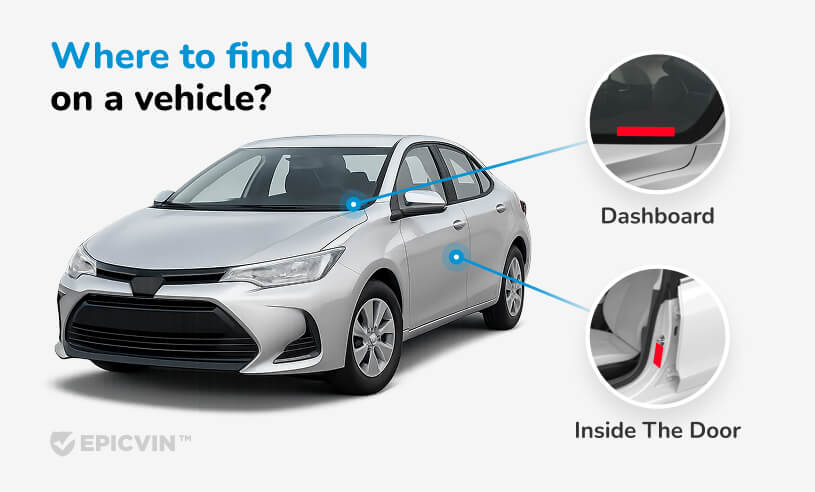
How to Read a VIN Number Like a Pro
From understanding the VIN number breakdown to uncovering a vehicle’s history,...

Free RAM VIN Decoder! 🚗 See specs, build sheet, recalls basic history—no sign-up. 🛡️✅ Need accidents, mileage, title? Upgrade in one click.
Looking for the VIN?
Here is there you’ll find it:

Every vehicle manufactured after 1981 has a unique 17-character vehicle identification number (VIN). Our VIN decoder instantly reveals your RAM's specs. Search for safety recalls and manufacturing details. Learn what VIN means to verify authenticity and make informed purchasing decisions before buying any used vehicle. Your vehicle's VIN serves as the primary security identifier.
Decoding your vehicle identification number takes seconds with our free VIN decoder system.

Your vehicle's unique identifier appears in multiple locations for enhanced security purposes.
| Key Risk | Impact on Buyers | Mitigation Steps |
|---|---|---|
| Theft Risk | ~1 in 50 pickup trucks is reported stolen each year | VIN-level alerts and ultra-lock security systems |
| Unrepaired Safety Recalls | ≈5% of used Rams still have open recalls | Always check NHTSA recall status using the vehicle's VIN |
| Depreciation Over Time | Ram 1500 loses ~25% value in the first 3 years after purchase | Review price trends on VIN history sites |
| Odometer Rollback Fraud | An estimated ~0.3% of used Rams are involved in rollback fraud | Compare DMV mileage vs auction photos |
| Hidden Flood or Salvage History | Up to 2% of listings mislabel water-damaged Rams as "clean" | Use full history reports with photos and security checks |
Risk Reduction: Reduce risks: Checking VIN reports, including photographs and government data. Always compare original specifications with the current condition using your vehicle's VIN information.
| Issue | Affected Models, Symptoms, Average Repair Cost |
|---|---|
| Tailgate actuator failure | 2014–2018 Ram 1500 (50k–80k mi); tailgate will not open/close. ≈ $400 replacement |
| Transmission shift solenoid | 2019–2021 Ram 2500/3500 Cummins (60k–100k mi); rough shifting. ≈ $500 replacement |
| A/C evaporator leak | 2013–2016 Ram 1500 (40k–70k mi); weak or no A/C. ≈ $650 parts & labor |

Each character in your vehicle's unique sequence tells a specific story about your VIN composition.
There are some other details that RAM owners and buyers should know:
Here's how our VIN decoder interprets a sample sequence (1C6RR6FG2HS603785):
| Symbols | Sample | What It Reveals |
|---|---|---|
| 1 | 1 | The United States as the country of origin |
| 2 | C | Chrysler/Stellantis as a vehicle manufacturer |
| 3 | 6 | Truck vehicle type |
| 4-8 | RR6FG | Body type, engine code, restraint system, model line, and transmission type |
| 9 | 2 | Check digit for validation |
| 10 | H | 2017 model year |
| 11 | S | Sterling Heights assembly plant |
| 12-17 | 603785 | Individual vehicle serial number |
Year 2022
Make RAM
Model 4500
Fuel Type Diesel
Engine 6.7L In-Line
Made in MEXICO
Our free VIN decoder reveals comprehensive vehicle specs and manufacturing details instantly from your car's VIN.
EpicVIN's daily DMV sync ensures 99% of new Ram VINs are indexed within hours of registration, providing crucial VIN information for security verification.— Alex Black, CMO, EpicVIN
Analyze your car's VIN for free basic specs and recalls. Upgrade instantly for detailed accident records, market value assessment, and complete ownership history.
Check the dashboard through the windshield, driver's door jamb, engine bay, or title documents for your VIN.
Yes, engine code position reveals the eTorque mild-hybrid system presence in compatible models through VIN analysis.
RAM trucks used Dodge VIN codes until 2010. Then, RAM became a separate brand, affecting what VIN means for older models.
Your VIN shows base specs; payload varies by options. Check the driver's door sticker for exact ratings.
Dealers hide digits to prevent buyers from running independent history checks and security verification before bidding.
Fleet coding appears in positions 4-5 of your VIN, showing commercial or government original purchase intent.
Canadian market vehicles may have different option codes and safety equipment requirements affecting VIN data accuracy.
Position 11 shows plant. "S" = Sterling Heights, Michigan; "P" = Saltillo, Mexico.
Factory lift packages appear in option codes within your VIN, but aftermarket modifications won't show.
Position 4 identifies body type: "R" = Regular Cab, "C" = Crew Cab, "G" = Chassis Cab configurations.
Discover expert tips, news and advice on buying and maintaining used vehicles

From understanding the VIN number breakdown to uncovering a vehicle’s history,...

Our team will tell you about budgeting for your new auto payments

Discover expert tips on buying a used car with our comprehensive guide.